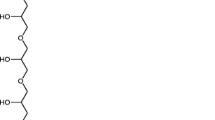Abstract
Foam bilayers from individual and mixed phosphatidylcholines are experimentally studied at different temperatures. Occurrence of a chain-melting phase transition in the foam bilayers is detected by two independent parameters—the critical concentrationC c for formation of foam bilayer and the foam bilayer thickness. The data forC c are discussed on the basis of the hole-nucleation theory, which applies the Ising model to foam bilayers and uses the mean-field approximation for interpretation of their stability. This allows the determination of the binding energy of a phospholipid molecule in gel and liquid-crystalline foam bilayers. New possibilities to relate the microscopic and macroscopic characteristics of foam bilayers are demonstrated.
Similar content being viewed by others
References
D. Kashchiev and D. Exerowa, Nucleation mechanism of rupture of Newtonian black films. I. Theory,J. Colloid Interface Sci. 77:501–511 (1980).
D. Exerowa and D. Kashchiev, Hole-mediated stability and permeability of bilayers,Contemp. Phys. 27:429–461 (1986).
A. V. Prokhorov and B. V. Derjaguin, On the generalized theory of bilayer film rupture,J. Colloid Interface Sci. 125:111–121 (1988).
Yu. A. Chizmadzhev, V. B. Arakelyan, and V. F. Pastushenko, Electric breakdown of bilayer lipid membranes. III. Analysis of possible mechanisms of defect origination,Bioelectrochem. Bioenerg. 6:63–70 (1979).
D. Kashchiev and D. Exerowa, Bilayer lipid membrane permeation and rupture due to hole formation,Biochim. Biophys. Acta 732:133–145 (1983).
D. Exerowa, D. Kashchiev, and D. Platikanov, Stability and permeability of amphiphile bilayers,Adv. Colloid Interface Sci. 40:201–256 (1992).
D. Exerowa, R. Cohen, and A. Nikolova, Newton black films stabilized with insoluble monolayers obtained by adsorption from the gas phase,Colloids Surfaces 24:43–49 (1987).
D. Chowdhury and D. Stauffer, Nucleation and size-distribution of holes in a microscopic model of Newton black films,Physica A 189:70–80 (1992).
D. Morawietz, D. Chowdhury, S. Vollmar, and D. Stauffer, Simulation of Widom model kinetics for microemulsions,Physica A 187:126–132 (1992).
P. Yeagle,The Membranes of Cells (Academic Press, New York, 1987).
K. Larsson, Physical properties—Structural and physical characteristics, inThe Lipid Handbook, F. D. Gunstone, J. L. Harwood, and F. B. Padley, eds. (Chapman and Hall, London, 1986), pp. 321–384.
C. Grabielle-Madelmont and R. Perron, Calorimetric studies on phospholipid-water systems. I. DL-Dipalmitoylphosphatidylcholine (DPPC)-water system,J. Colloid Interface Sci. 95:471–482 (1983).
D. M. Small, Phase equilibria and structure of dry and hydrated egg lecithin,J. Lipid Res. 8:551–557 (1967).
C. M. Knobler, Recent developments in the study of monolayers at the air-water interface,Adv. Chem. Phys. 77:397–449 (1990).
L. G. Mikayelyan and S. A. Adzhyan, Physical-chemical characteristics of flat lipid membranes during a phase transition,Biophysics 31:698–702 (1986).
J. Nagle, Theory of the main lipid bilayer phase transition,Annu. Rev. Phys. Chem. 31:157–195 (1980).
A. Sheludko, Thin liquid films,Ads. Colloid Interface Sci. 1:391–464 (1967).
D. Exerowa, T. Kolarov, and Khr. Khristov, Direct measurement of disjoining pressure in black foam films. I. Films from an ionic surfactant,Colloids Surfaces 22:171–185 (1987).
T. L. HillAn Introduction to Statistical Thermodynamics (Addison-Wesley, Reading, Massachusetts, 1960).
D. Exerowa, B. Balinov, A. Nikolova, and D. Kashchiev On the probability for observation of Newtonian black film in foam film,J. Colloid Interface Sci. 95:289–291 (1983).
Ch. Tanford, Hydrophobic free energy, micelle formation and the association of proteins with amphiphiles,J. Mol. Biol. 67:59–74 (1972).
R. Cohen, R. Koynova, B. Tenchov and D. Exerowa, Direct measurement of interaction forces in free thin liquid films stabilized with phosphatidylcholine,Eur. Biophys. J. 20:203–208 (1991).
H. J. Hinz and J. M. Surtevant, Calorimetric studies of dilute aqueous suspensions of bilayers formed from synthetic L-α-lecithins,J. Biol. Chem. 247:6071–6075 (1972).
E. M. Duyvis, Thesis, Utrecht University, Utrecht (1962).
B. G. Tenchov, H. Yao, and I. Hatta, Time-resolved X-ray diffraction and calorimetric studies at low scan rates. I. Fully hydrated dipalmitoylphosphatidylcholine (DPPC) and DPPC/water/ethanol phases,Biophys. J. 56:757–768 (1989).
W. Tamura-Lis, L. J. Lis, S. Qadri, and P. J. Quin, Ethanol-phosphatidylcholine interactions: A real time X-ray diffraction study,Mol. Cryst. Liq. Cryst. 178:79–88 (1990).
N. Yellin and I. W. Levin, Hydrocarbon chaintrans-gauche isomerization in phospholipid bilayer gel assemblies,Biochemistry 16:642–647 (1977).
M. J. Janiak, D. M. Small, and G. G. Shipley, Nature of the thermal pretransition of synthetic phospholipids: Dimyristoyl- and dipalmitoyllecithin,Biochemistry 15:4575–4580 (1976).
C. A. Helm, H. Möhwald, K. Kjaer, and J. Als-Nielsen Phospholipid monolayer density distribution perpendicular to the water surface. A synchrotron X-ray reflectivity study,Europhys. Lett. 4:697–703 (1987).
A. Nikolova, D. Kashchiev, and D. Exerowa, Effect of temperature on the rupture of Newton black foam films,Colloids Surfaces 36:339–351 (1989).
I. Penev, D. Exerowa, and D. Kashchiev Rupture of Newtonian black foam films by α-particle irradiation: Hole mechanism,Colloids Surfaces 25:67–75 (1987).
V. G. Ivkov and G. N. Beresovskii,Lipidnii Bisloi Biologicheskih Membran (Nauka, Moscow, 1982).
J. D. Litster, Stability of lipid bilayers and red blood cell membranes,Phys. Lett. A 53A(3):193–194 (1975).
F. P. Jones, P. Tevlin and L. E. H. Trainor, Phase transitions of lipid bilayers. II. Mean field theory,J. Chem. Phys. 91:1918–1925 (1989).
R. E. Goldstein and S. Leibler, Structural phase transitions of interacting membranes,Phys. Rev. A 40:1025–1035 (1989).
A. Petrov, M. Mitov, and A. Derzhanski, Edge energy and pore stability in bilayer lipid membranes, inAdvances in Liquid Crystal Research and Applications, Vol. 2, L. Bata, ed. (Pergamon Press, Oxford, 1980), pp. 695–737.
W. Harbich and W. Helfrich, The swelling of egg lecithin in water,Chem. Phys. Lipids 36:39–63 (1984).
Author information
Authors and Affiliations
Rights and permissions
About this article
Cite this article
Nikolova, A., Exerowa, D. Phase transitions in phosphatidylcholine foam bilayers. J Stat Phys 78, 147–160 (1995). https://doi.org/10.1007/BF02183343
Received:
Accepted:
Issue Date:
DOI: https://doi.org/10.1007/BF02183343




